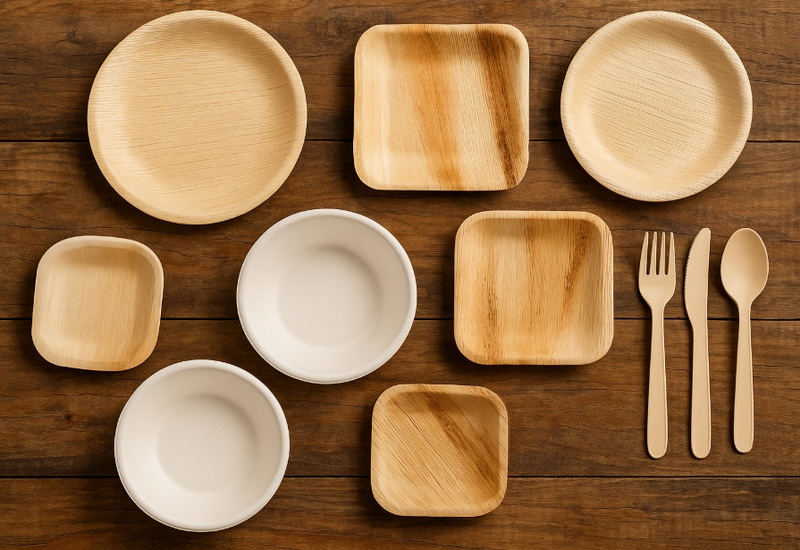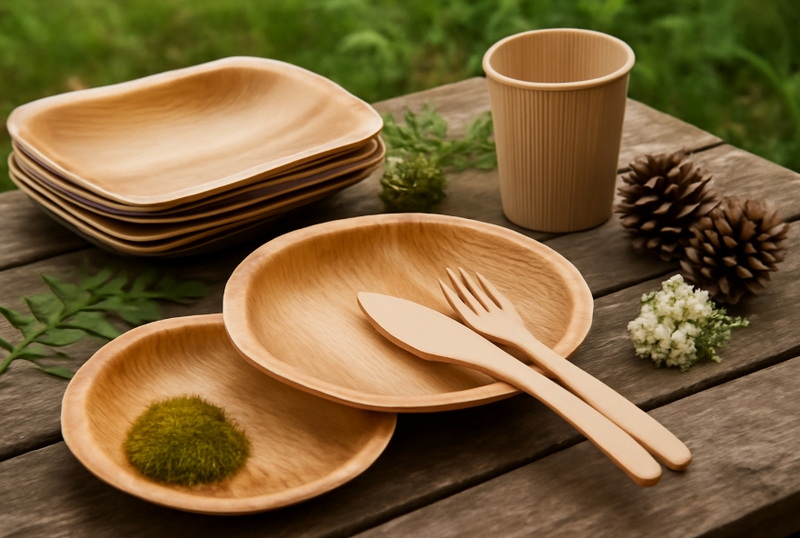
Content Menu
● Introduction
● Types of Disposable Plates
>> By Material
>> By Size and Shape
● Top Disposable Plate Manufacturers and Suppliers in the U.S.
>> 1. Huhtamaki
>> 2. Dart Container Corporation
>> 3. International Paper
>> 4. Georgia-Pacific LLC (Dixie® Brand)
>> 5. Pactiv LLC
>> 6. D&W Fine Pack
>> 7. Aspen Products, Inc.
>> 8. PacknWood
>> 9. Chic Leaf
>> 10. Dtocs LLC
● Manufacturing Process: From Raw Material to Finished Plate
>> Paper Plate Manufacturing
>> Bamboo and Palm Leaf Plate Manufacturing
● Key Considerations When Choosing a Disposable Plate Supplier
● Sustainability Trends in Disposable Tableware
● Conclusion
● Frequently Asked Questions
>> 1. What is the best material for disposable plates?
>> 2. Can disposable plates handle hot or oily foods?
>> 3. Are disposable plates microwave-safe?
>> 4. Can I order custom-branded disposable plates?
>> 5. How can I purchase disposable plates in bulk for my business?
Disposable plates have become an indispensable part of modern life, particularly in the food service, catering, hospitality, and event planning industries. As consumers and businesses continue to seek convenient, hygienic, and increasingly sustainable solutions, the demand for reliable disposable plate manufacturers and suppliers in the United States has never been higher. This comprehensive guide explores the leading companies, types of disposable plates, manufacturing processes, sustainability trends, and key considerations for selecting the right supplier for your needs.

Introduction
Disposable plates are essential for a wide range of applications, from fast food outlets and cafeterias to large-scale events and private gatherings. Their popularity is driven by their convenience, cost-effectiveness, and ability to maintain hygiene standards. In recent years, environmental concerns have also prompted manufacturers and suppliers to innovate, offering more sustainable and eco-friendly options to meet the evolving needs of consumers and businesses alike.
Types of Disposable Plates
Understanding the different types of disposable plates available is crucial for making the best choice for your business or event. Disposable plates can be categorized by material, size, and intended use.
By Material
Paper Plates:
Paper plates are lightweight, generally cost-effective, and widely used for serving snacks, desserts, and light meals. Many paper plates are coated with a thin layer of plastic or wax to resist moisture and grease, making them suitable for both hot and cold foods. Compostable and biodegradable paper plates are increasingly popular as sustainable alternatives.
Plastic Plates:
Plastic disposable plates, typically made from polystyrene or polypropylene, are valued for their durability and resistance to bending under the weight of heavier foods. While they are convenient and sturdy, traditional plastic plates face increasing scrutiny due to their environmental impact. Some manufacturers now offer recyclable or biodegradable plastic options.
Foam Plates:
Foam plates, usually made from expanded polystyrene, provide excellent insulation and are lightweight and affordable. However, due to environmental concerns and regulatory restrictions in some regions, their usage is declining in favor of more sustainable materials.
Bamboo Plates:
Bamboo plates are a premium, eco-friendly option. They are biodegradable, compostable, and offer a natural, elegant appearance. Bamboo plates are strong and suitable for both hot and cold foods, making them a popular choice for upscale events and environmentally conscious brands.
Bagasse Plates:
Bagasse plates are made from the fibrous residue left after sugarcane is processed. They are compostable, heat-resistant, and sturdy, making them an excellent alternative to plastic and foam plates. Bagasse plates are gaining popularity in the U.S. as businesses seek greener options.
By Size and Shape
Disposable plates come in a variety of sizes and shapes to suit different serving needs:
| Plate Size | Typical Use |
| 6-7 inches | Snacks, desserts, appetizers |
| 8-9 inches | Salads, light meals |
| 10-12 inches | Full meals, buffets, catering |
Round, square, and compartmentalized plates are common, allowing for versatility in presentation and portion control.
Top Disposable Plate Manufacturers and Suppliers in the U.S.
The United States is home to numerous reputable disposable plate manufacturers and suppliers, each offering unique strengths and product lines. Below are some of the most prominent and trusted names in the industry:
1. Huhtamaki
- Headquarters: Espoo, Finland (major U.S. operations)
- Specialty: Sustainable, innovative food packaging solutions
- Products: Paper, molded fiber, and compostable plates
- Strengths: Global leader in eco-friendly packaging, serving major foodservice brands with a focus on quality and sustainability.
2. Dart Container Corporation
- Headquarters: Mason, Michigan
- Specialty: Foam and plastic containers, cups, and plates
- Products: A wide range of disposable tableware for restaurants, healthcare, and institutional use
- Strengths: Industry leader in foodservice packaging innovation and large-scale production capabilities.
3. International Paper
- Headquarters: Memphis, Tennessee
- Specialty: Fiber-based packaging, pulp, and paper products
- Products: Disposable plates, packaging, and printing materials
- Strengths: Extensive U.S. manufacturing footprint and strong commitment to sustainable practices.
4. Georgia-Pacific LLC (Dixie® Brand)
- Headquarters: Atlanta, Georgia
- Specialty: Tissue, pulp, paper, and disposable tableware
- Products: Dixie® paper plates, bowls, and cups
- Strengths: Over a century of consumer trust, rigorous quality control, and advanced sustainability initiatives.
5. Pactiv LLC
- Headquarters: Lake Forest, Illinois
- Specialty: Food packaging and disposable tableware
- Products: Plates, trays, and containers for restaurants and supermarkets
- Strengths: Broad product range and strong commitment to sustainability and innovation.
6. D&W Fine Pack
- Headquarters: Elk Grove Village, Illinois
- Specialty: Food packaging, containers, trays, and tableware
- Products: Disposable plates for foodservice and retail
- Strengths: Focus on quality, innovation, and customer service.
7. Aspen Products, Inc.
- Headquarters: Kansas City, Missouri
- Specialty: Private label disposable plates, cups, bowls, and lunch bags
- Products: Paper plates for grocery, club, and foodservice distributors
- Strengths: Family-owned, national distribution, and expertise in custom program development.
8. PacknWood
- Headquarters: New York, NY
- Specialty: Eco-friendly, recyclable tableware
- Products: Bamboo, palm leaf, and paper disposable plates
- Strengths: Focus on sustainability and innovative design, catering to environmentally conscious businesses.
9. Chic Leaf
- Headquarters: Walnut, CA
- Specialty: Palm leaf plates, trays, and bowls
- Products: Biodegradable and compostable tableware
- Strengths: Plant-based, lightweight, and durable alternatives to plastic, ideal for eco-friendly events.
10. Dtocs LLC
- Headquarters: U.S. based
- Specialty: Areca palm leaf plates and tableware
- Products: Compostable, USDA-approved plates for fine dining and events
- Strengths: Emphasis on greener, more environmentally conscious living and high-quality, natural materials.

Manufacturing Process: From Raw Material to Finished Plate
The production of disposable plates involves several sophisticated steps to ensure quality, safety, and sustainability.
Paper Plate Manufacturing
1. Raw Material Preparation: High-quality, food-grade paper or cardboard is selected. For eco-friendly options, bagasse or bamboo pulp may be used.
2. Cutting and Shaping: Paper sheets are cut into blanks using die-cutting machines.
3. Forming: The blanks are pressed into shape using heated molds, forming the plate's structure and rim.
4. Coating: Plates may be coated with a thin layer of plastic or biodegradable material to resist moisture and grease.
5. Printing and Customization: Designs, logos, or branding can be printed onto the plates for marketing or event purposes.
6. Quality Control: Plates are checked for strength, uniformity, and food safety compliance.
7. Packaging: Finished plates are stacked, wrapped, and boxed for shipment to distributors and end users.
Bamboo and Palm Leaf Plate Manufacturing
1. Harvesting: Bamboo or palm leaves are collected and thoroughly cleaned.
2. Pressing: Leaves are pressed into shape using heated molds, often without additional chemicals or additives.
3. Trimming and Finishing: Edges are trimmed, and plates are inspected for quality and consistency.
4. Sterilization: Plates are sterilized to ensure they are safe for food contact.
5. Packaging: Plates are packed and prepared for shipment, often in eco-friendly packaging materials.
Key Considerations When Choosing a Disposable Plate Supplier
Selecting the right disposable plate manufacturer or supplier is crucial for ensuring product quality, reliability, and alignment with your business values. Here are some essential factors to consider:
- Material Quality: Ensure that the plates are made from food-safe, durable materials that suit your intended use, whether for hot meals, oily foods, or cold dishes.
- Sustainability: Choose suppliers that offer biodegradable, compostable, or recyclable products to support your environmental goals and appeal to eco-conscious consumers.
- Customization Options: Many suppliers provide custom printing and sizing for branding, events, or special requirements. This can enhance your brand visibility and customer experience.
- Bulk Availability and Lead Times: For large events or ongoing business needs, select suppliers who can reliably deliver large quantities on time.
- Certifications: Look for suppliers with relevant certifications such as USDA, FSC, or ISO, which indicate adherence to food safety and environmental standards.
- Cost and Value: Balance price with quality and sustainability to maximize value for your business. Bulk purchasing often results in better pricing and consistent supply.
- Customer Service and Support: A responsive supplier can help address any issues quickly and ensure a smooth ordering process.
Sustainability Trends in Disposable Tableware
The disposable plate industry is undergoing significant transformation in response to environmental concerns and regulatory changes. Here are some of the most important sustainability trends:
- Shift to Biodegradable Materials: Manufacturers are increasingly using bagasse, bamboo, and palm leaf to replace traditional plastics and foam, reducing landfill waste and carbon footprint.
- Compostable and Recyclable Products: There is a growing emphasis on products that break down naturally or can be recycled, helping to close the loop in the product lifecycle.
- Certifications and Transparency: Suppliers are obtaining certifications and providing detailed product information to build trust with eco-conscious buyers.
- Innovative Designs: Companies are developing plates with improved strength, heat resistance, and aesthetic appeal, all while maintaining sustainable credentials.
- Corporate Social Responsibility: Many manufacturers are adopting CSR initiatives, such as using renewable energy, reducing water usage, and supporting community recycling programs.
Conclusion
The demand for high-quality, sustainable disposable plates is driving innovation and growth among manufacturers and suppliers in the United States. Whether you are a restaurant owner, caterer, event planner, or distributor, understanding the types of disposable plates available, the leading manufacturers, and the latest industry trends will help you make informed decisions that benefit your business and the environment. By prioritizing material quality, sustainability, and supplier reliability, you can ensure that your disposable tableware meets the highest standards of performance and responsibility.

Frequently Asked Questions
1. What is the best material for disposable plates?
The best material depends on your needs: plastic for durability, paper for eco-friendliness, and compostable options like bagasse or bamboo for sustainability.
2. Can disposable plates handle hot or oily foods?
Yes, heavy-duty paper, bagasse, bamboo, and certain plastics are designed to withstand hot and oily foods without bending or leaking.
3. Are disposable plates microwave-safe?
Some materials, such as paper and bagasse, are microwave-safe. Always check product specifications to ensure safety.
4. Can I order custom-branded disposable plates?
Many manufacturers and suppliers offer customizable options for branding, events, or special occasions. Check with your supplier for details.
5. How can I purchase disposable plates in bulk for my business?
You can buy directly from manufacturers, wholesalers, or reputable distributors. Ordering in bulk often results in better pricing and consistent supply.

















